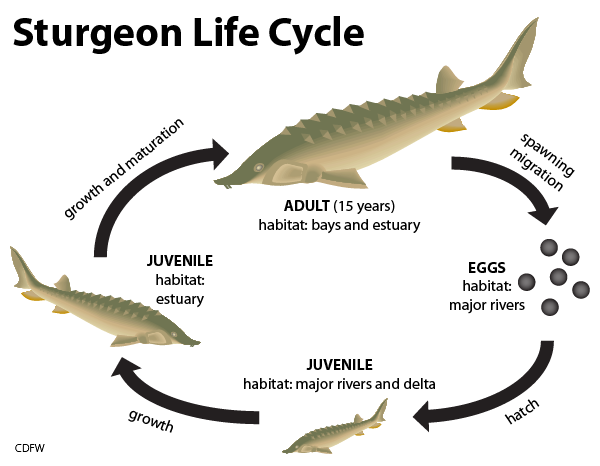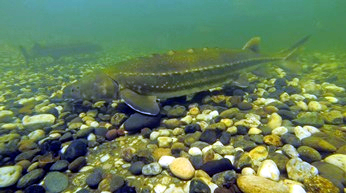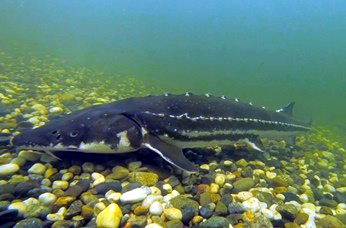Biology
 Click/tap to enlarge in new tab
Click/tap to enlarge in new tab
 Adult White Sturgeon. CDFW photo by Mike Healey.
Adult White Sturgeon. CDFW photo by Mike Healey.
 Adult Green Sturgeon. CDFW photo by Mike Healey.
Adult Green Sturgeon. CDFW photo by Mike Healey.
Sturgeon are members of Family Acipenseridae, an ancient lineage of bony fishes that coexisted with the dinosaurs. The group, which also includes paddlefishes, diverged from other fishes at least 200 million years ago in the early Jurassic period. There are 25 species of sturgeon worldwide, two of which, White (Acipenser transmontanus) and Green (A. medirostris) – are native to California. Although they are a bony fish (Class Osteichthyes), rather than a cartilaginous fish like sharks (Class Chondrichthyes), sturgeon actually have very little true bone. Most of their internal skeleton is composed of cartilage, as in sharks. Bone is mostly restricted to plates around the head, the spines of the pectoral fins, and the heavy armor-like scales called scutes that line their body. Sturgeon have been referred to as living fossils because they retain a number of physical traits that are thought to represent the ancestral condition of fishes. These include a heterocercal tail in which the vertebrae extend into an upper lobe that is longer than the lower lobe, a spiral valve intestine, and electroreceptors similar to sharks. Their mouth is also unique and is thought to have evolved separately from other fishes, forming a toothless, extendible tube that is good for sucking food items up off the bottom. Sturgeon have no teeth as adults, instead food is swallowed whole. Their diet usually includes bottom-dwelling crustaceans such as amphipods, shrimp, and crabs, as well as bivalves, fishes, and fish eggs.
Sturgeon are large, very long-lived and late to mature. All sturgeon are migratory, typically spending most of their adult lives in estuaries, the lower reaches of rivers, or the ocean. They migrate upstream in large freshwater rivers to spawn in cool, deep, swift flowing river reaches over gravel and cobble bottoms. Sturgeon do not die after spawning like Pacific salmon, and the both species are capable of repeated migrations every 2-6 years. Juvenile sturgeon remain in the river for a period of time before migrating to the estuary or bay.
Threats
Unfortunately, the life-history traits of sturgeon make them very vulnerable to human impacts. Fish ladders designed for salmon or shad are not effective at passing sturgeon, so dams and water diversions can impede migration and block ancestral spawning grounds. Changes to river hydrology can impact water quality, such as temperature or dissolved oxygen, which may particularly harm sensitive life-stages such as eggs or larvae. Changes to how rivers are managed can also degrade necessary spawning habitat by increasing siltation, covering the coarse gravel and cobble substrates that sturgeon require for spawning. Additionally, pollution from runoff, and predation or changes to the food web from introduced non-native species may impact these fishes. Sturgeon have historically been sought after in fisheries, both for their meat and for eggs for caviar. Because they are so slow to reproduce, they are very sensitive to overfishing and require careful management.
Status in California
Of the species found in California, White Sturgeon are a candidate species for listing as Threatened under the California Endangered Species Act. Green Sturgeon from the southern population were listed as threatened under the federal Endangered Species Act in 2006. Northern population Green Sturgeon are not state or federally listed, but they both are categorized as a state Species of Special Concern. The American Fisheries Society considers the survival of sturgeon to be dependent on conservation measures taken to protect them. Worldwide, sturgeon are considered the most threatened group of animals on the IUCN Red List of Threatened Species, with 85% species considered to be at risk of extinction.
Take Action to Help Sturgeon
What is CDFW doing now?
- Monitoring and evaluating sturgeon populations
- Conducting a Status Review of White Sturgeon to evaluate their candidacy for listing under the California Endangered Species Act
- Investigating habitat use by juvenile sturgeon
- Collecting valuable information via Sturgeon Fishing Report Cards
- Teaming with federal, state, and non-government partners to monitor the causes of death of adult sturgeon, including large vessel strikes and marine mammal predation
- Making regulation changes as needed
- Evaluating changes in habitat quality
- Examining delta hydrology and water project operations year-round
What can you do?
You can assist the Delta ecosystem and sturgeon recovery in several ways:
- Follow Best Handling Practices for the Catch & Release of White Sturgeon. It is the responsibility of every angler to handle sturgeon with care and release them unharmed.
- Complete your Sturgeon Report Card and return it on time. Report sturgeon fishing results ONLINE, or mail sturgeon report cards to PO Box 944209, Sacramento CA 94244.
- Follow CA fishing regulations, including releasing all Green Sturgeon immediately. Fishing for White Sturgeon is catch and release only, no harvest is permitted. White Sturgeon over 60 inches may not be landed and should be released immediately, and with as minimal handling as possible.
- Report poaching and illegal fishing: 1-888-334-CalTIP (888-334-2258)
- Report all dead sturgeon carcasses to the California carcass tip line CASturgeonResearch@gmail.com. Provide as much information as possible including:
- Detailed location (such as GPS coordinates, landmarks, cellphone map app screenshots).
- Pictures (please include common items for scale such as coins or dollar bills, beverage can, etc.).
- Do not move or damage the carcass. Specialists will locate the carcass and take measurements and samples as part of this ongoing monitoring study.
- Water conservation - the more water we conserve the less water needs to be exported from the Delta.
For more information, contact CDFW's Fisheries Branch, Sturgeon@wildlife.ca.gov.
CDFW
Other Agencies
Sturgeon Carcass Reporting
Researchers studying the causes of death of adult sturgeon (PDF) request that any observations of sturgeon carcasses be reported to CASturgeonResearch@gmail.com.